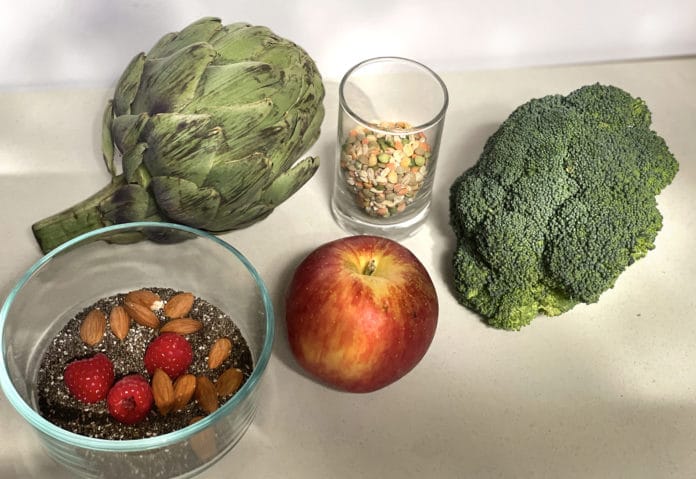According to the USDA, the daily adequate fiber intake for women is 25 grams and for men it is 38 grams. [1] Unfortunately, only about 5% of Americans reach that recommended amount. So, what is fiber and how can we make sure that we are getting enough of it every day?
What Is Fiber?
Fiber is the edible portion of plants that cannot be digested or absorbed by the body, unlike fats, proteins, and carbohydrates which all get broken down and absorbed during digestion. Fiber is found exclusively in plants and not found naturally in animal products. According to the National Library of Medicine, diets high in fiber intake “are linked to less cardiovascular disease and fiber plays a role in gut health, with many effective laxatives actually isolated fiber sources. Higher intakes of fiber are linked to lower body weights.” [2] There are two types of fiber: soluble and insoluble.
Soluble fiber
Soluble fiber dissolves in water and turns into a gel-like substance in the body’s digestive process. According to Harvard Medical School, soluble fiber “helps lower cholesterol levels, reduce the risk of heart disease, and regulate blood sugar levels.” [3] While the process in which soluble fiber reduces cholesterol is yet to be defined, evidence seems to suggest that “some soluble fibers bind bile acids or cholesterol during the intraluminal formation of micelles” causing “an up-regulation of the LDL receptors and thus increased clearance of LDL cholesterol.” [4] Soluble fiber regulates blood sugar levels by slowing the absorption of glucose from our food. Some examples of foods that contain soluble fiber are oats, apples, and psyllium.
Insoluble fiber
Insoluble fiber does not dissolve in water. Instead, it draws in water, softens the stool, and speeds up the passing of foods through our digestive tract. Insoluble fiber will help to prevent or treat constipation. Some examples of foods that contain insoluble fiber are whole grains, seeds, and vegetables.
Ten fiber-rich foods
According to the Mayo Clinic, here is a list of high fiber foods to add to your diet [5]:
- Lentils, boiled – 15.5 grams of fiber per cup
- Black beans, boiled – 15 grams of fiber per cup
- Chia seeds – 10 grams of fiber per ounce
- Green peas, boiled – 9 grams of fiber per cup
- Raspberries – 8 grams of fiber per cup
- Barley, cooked – 6 grams of fiber per cup
- 1 medium pear – 5.5 grams of fiber
- Broccoli, boiled – 5 grams of fiber per cup
- Quinoa, cooked – 5 grams of fiber per cup
- Almonds – 3.5 grams of fiber per ounce
What Is a Microbiome and How Does Fiber Impact It?
The microbiome is a balance of “good” and “bad” microbes. When we are healthy, the good and bad microbes coexist in our gut. However, certain lifestyle habits, like our diet or what medications we are taking, can throw the balance off and cause a more disease-prone body. Our microbiome impacts our immune system, brain health, and produces certain vitamins. The health of our microbiome informs the health of the rest of our body.
Our microbiome bacteria feed off of prebiotics, which are indigestible compounds found in plant fiber that promote the growth of good bacteria in the gut. According to the National Library of Medicine, for fiber to be considered “prebiotic” it has to: resist absorption in the upper tract, ferment from intestinal microflora, and promote the growth or activity of intestinal bacteria. Examples of foods that contain prebiotic fiber are asparagus, artichoke, and oats. [6] Prebiotics and probiotics work hand-in-hand to promote a healthy balance of microbes so it is beneficial to take a high-quality probiotic or eating probiotic-rich foods like kimchi, kefir, or kombucha when adding foods rich in prebiotic fiber into your diet.
How to up your fiber intake
Increase your fiber intake by including fiber-rich vegetables, fruits, grains, and legumes in each meal. Since animal products don’t contain any fiber, pair your animal proteins and dairy with a good source of fiber. A simple high-fiber meal could be 1 cup of cooked lentils, 1 cup of cooked broccoli, and your protein source of choice. That meal alone would come out to 25.5 grams of fiber. When increasing the amount of fiber in your diet, it is important to drink an adequate amount of water for your size and activity level to avoid any bloating, gas, or constipation while your body adjusts to the diet change.
[1] https://www.usda.gov/media/blog/2015/03/31/online-nutrition-resources-your-fingertips
[2] & [6] https://www.ncbi.nlm.nih.gov/pmc/articles/PMC3705355/
[3] https://www.health.harvard.edu/blog/should-i-be-eating-more-fiber-2019022115927
[4] https://academic.oup.com/ajcn/article/69/1/30/4694117
[5] https://www.mayoclinic.org/healthy-lifestyle/nutrition-and-healthy-eating/in-depth/


